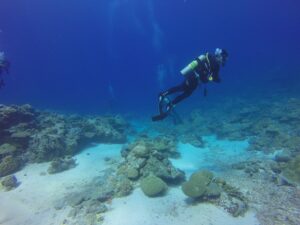
Diving on air versus nitrox is a topic that is often discussed among scuba divers. Both air and nitrox have their own unique benefits and drawbacks, and understanding the difference between the two can help you make an informed decision about which type of gas is best for you.
Air is the most common type of diving gas and is made up of roughly 21% oxygen and 79% nitrogen. It is readily available, inexpensive, and has been used for many years by recreational divers.
Nitrox, on the other hand, is a mixture of oxygen and nitrogen that contains a higher percentage of oxygen than air. It typically contains between 22% and 40% oxygen, with the most commonly used nitrox mixture being 32%.
One of the biggest advantages of diving on nitrox is that it reduces the amount of nitrogen absorbed into the body, which can reduce the risk of decompression sickness. This makes it a popular choice for divers who are diving deeper or making multiple dives in a single day. Nitrox also provides longer no-decompression limits, allowing divers to spend more time underwater.
However, there are also some drawbacks to diving on nitrox. It is more expensive than air, and is not always readily available at dive sites. Additionally, diving on nitrox requires additional training, as well as specialized equipment, such as an oxygen analyzer.
Another important factor to consider when deciding between air and nitrox is your level of experience. Nitrox diving is generally recommended for experienced divers who have a good understanding of decompression theory and dive planning.
When diving on air, divers must follow strict decompression limits to avoid the risk of decompression sickness. Decompression sickness occurs when nitrogen that has been absorbed into the body forms bubbles that can cause pain, paralysis, or even death in severe cases. This is why it is important for divers to plan their dives carefully, taking into account their depth, bottom time, and surface interval between dives.
In contrast, diving on nitrox reduces the amount of nitrogen absorbed into the body, which means that divers can stay underwater longer without having to worry about decompression limits. This is particularly useful for deep dives, where nitrogen absorption is highest, or for repetitive diving, where the risk of decompression sickness increases with each subsequent dive.
Another benefit of diving on nitrox is that it allows divers to spend more time at depth, as the longer no-decompression limits allow for more bottom time. This can be particularly useful for photographers and marine life enthusiasts, as it gives them more time to take photos or observe marine life without having to worry about decompression limits.
However, diving on nitrox also has its own set of limitations. One of the main limitations is the cost, as nitrox is typically more expensive than air. This is because nitrox is a specialized gas that requires specialized equipment, such as oxygen analyzers, to ensure that it is properly mixed and safe to breathe.
Additionally, diving on nitrox also requires additional training, as divers need to understand the principles of dive planning and decompression theory when using this type of gas. This is why nitrox diving is generally recommended for experienced divers who have a good understanding of dive planning and dive safety.
In conclusion, diving on air or nitrox both have their own benefits and limitations, and the choice between the two ultimately comes down to individual preference and dive conditions. Before making a decision, divers should consider factors such as cost, availability, training, and experience, as well as the type of diving they will be doing, such as deep diving or repetitive diving. Regardless of which type of diving gas you choose, always dive within your limits and follow safe diving practices.
